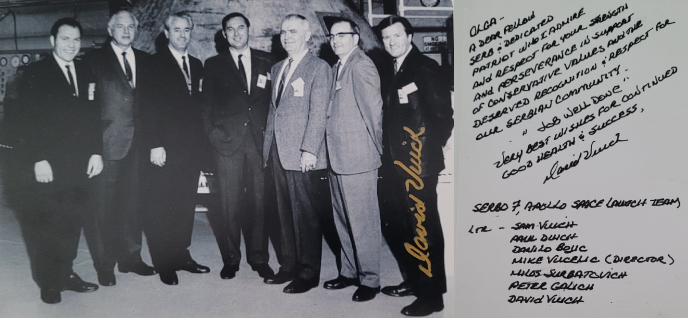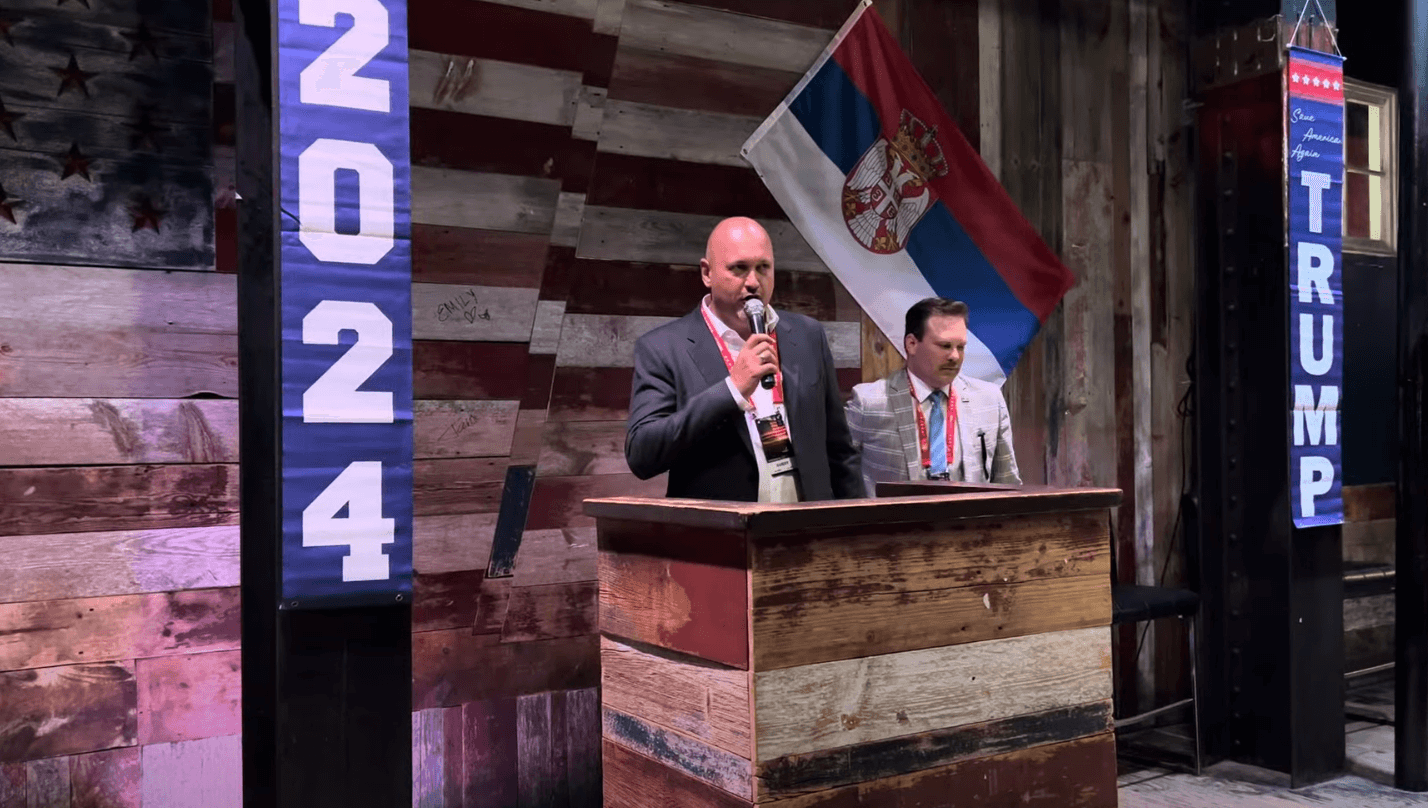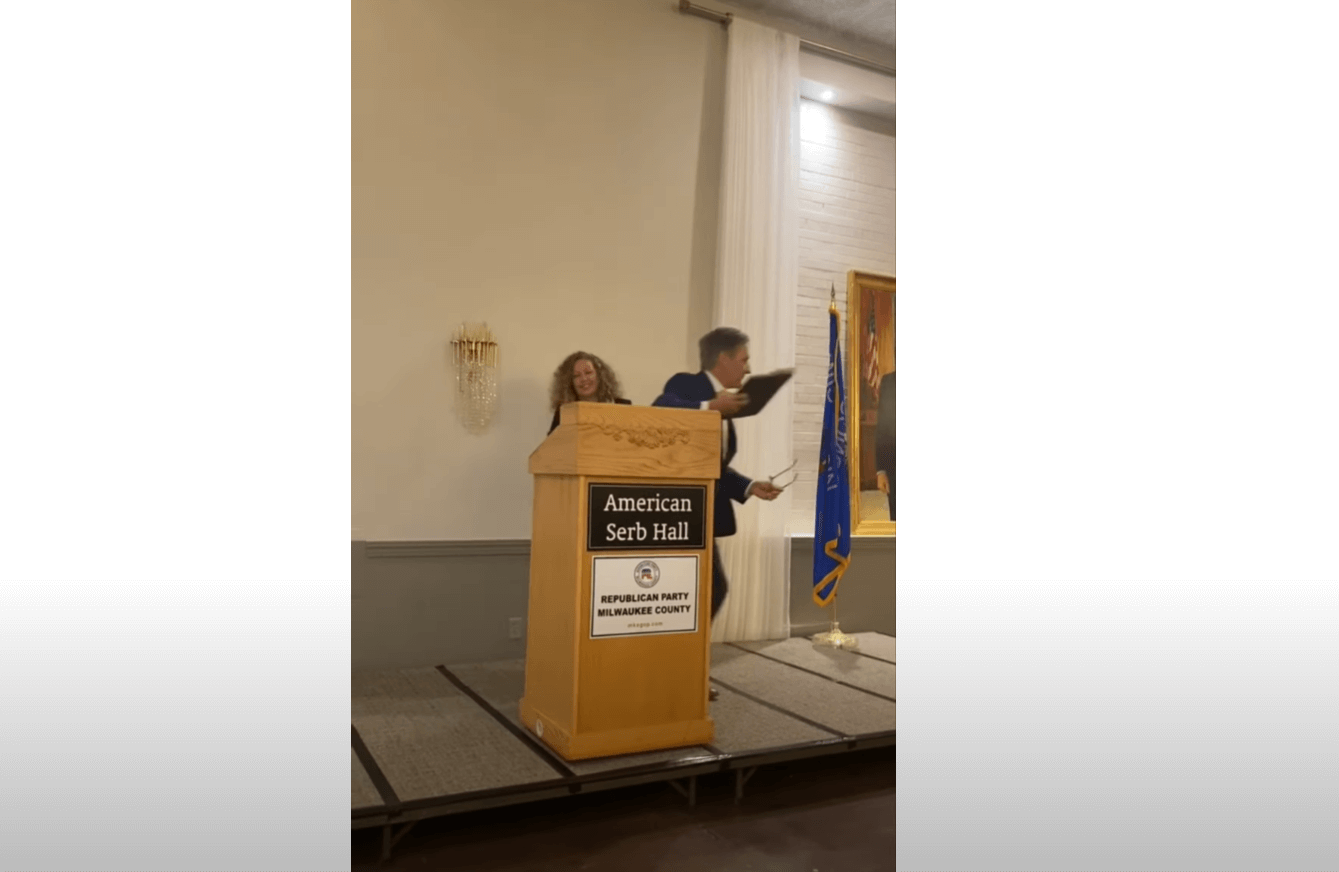
The TRUMP Affect/Effect on Global Stability w/ Special Guest Dr. Olga Ravasi
The TRUMP Affect/Effect on Global Stability w/ Special Guest Dr. Olga Ravasi In this post I am expressing my 1st Amendment Right of #FreeSpeech
The Serbs left their mark on every aspect of American society. Politics, science, the army, literature, arts, sport, and entrepreneurship. We‘ve all heard about Tesla or Pupin and their accomplishments, but how about many other untold stories and heroes we know nothing about? At least stories that were not known to many of us. Stories about Serbs who built America. This article will cover some of their most inspiring stories and anecdotes.
American optimism, a can-do attitude, and Serbian capability to adjust and overcome everything created and shaped American history.
The first generation of American Serbs was manual workers, usually gold-seekers and miners who, ounce by ounce and kilo by the kilo, developed their community. Miles and miles of American roads were soaked with their sweat. Over time, they did some amazing things that will never be forgotten.
Today, we’re going to walk you through their accomplishments.
„A man is born to work, to suffer and to fight; he who doesn’t, must perish” Nikola Tesla.
Nikola Tesla died poor but enlightened us all.
He “invented” the 20th and, some will say, even the 21st century. Many of his patents are still under the veil of mystery.
Tesla was not interested in wealth, awards, or fame. He lived and achieved all his greatness in the United States.
He invented the alternating-current power system that provides electricity to houses and buildings. Furthermore, he patented over 100 innovations and was a pioneer in radio communications.
Tesla predicted or contributed to numerous devices that have become ubiquitous in our society, such as remote control, neon and fluorescent lights, wireless transmission, computers, smartphones, laser beams, x-rays, and robotics.
Without his work, you would probably not have read this.
Experts and his successors said that much more of his work would be revealed in the future, which could revolutionize the world.
Even though Tesla worked heavily on his inventions, he found the time to help Serbs in the United States, whether in support or financial help.
Mikhail Idvorski Pupin (Mihajlo Pupin) came to the promised land with 5 cents in his pocket and became one of the greatest scientists ever.
Besides his inventions, he also rendered many patriotic acts for his homeland and Serbs in the U.S.
Working at the University of Columbia, he became a world-class professor, scientist, and inventor.
The method of inserting loading coils (of wire) along the transmission line at predetermined intervals was his most important invention (known as “Pupinization”). This theory and actual use made it feasible to send telephone conversations across great distances, which had previously been impossible.
His story is truly inspirational.
Pupin was the Honorary Consul of Serbia in America, the winner of the Pulitzer Prize, and a member of many American and European scientific institutions. In addition to being a member of the American Academy of Sciences and the Serbian Royal Academy, he has also been awarded honorary doctorates from 18 universities.
He improved telecommunications and contributed to the establishment of wireless telegraphy and telephony, radiology, and electrical engineering.
Along the way, he was an exceptional writer, a humanist, and one of the greatest benefactors Serbia has ever had.
Pupin actively worked on uniting Serbian organizations to strengthen the Serbian community in America.
Thanks to Pupin, a vast amount of material resources, medical equipment, and volunteers (more than 16,000) were organized and sent to Serbia during WWI.
Through the contacts he had, Pupin fought for the affirmation of Serbian and Yugoslav issues in America before and especially after WWI. He was a great friend of U.S. President Woodrow Wilson. That was the time when the Serbian flag flew over the White House.
A foreign flag was displayed at the White House for the first time in American history!
This gesture by President Woodrow Wilson towards Serbia was to show appreciation for their sacrifice because Serbia lost more than 26% of its population in WWI.
Also, this was almost the first time a majority of a country’s population had evacuated from its homeland during the war.
Thanks to his connections, Pupin lobbied for a more favorable demarcation after WWI for the formed Kingdom of Serbs, Croats, and Slovenes (the forerunner of Yugoslavia). Pupin also had close acquaintances with Theodore Roosevelt, Herbert Hoover, and business people like Carnegie and Edison. He was a prominent member of the Republican Party.
There’s a prevailing opinion that Tesla and Pupin were not in a great relationship (although some claim the opposite). They differed in personalities, although they had a similar path—both came as outsiders and became some of the most famous scientists.
Still, one of Pupin’s last wishes was to see Tesla. They met and talked for half an hour, and what they talked about will forever remain a secret.
Bill Gates once said of Pupin: “The information revolution in the United States would not have been possible without the discovery of Mikhail Pupin.”
The Apollo 11 spaceflight supports that claim. Magnificent minds originating from Serbia made important contributions to the team.
They participated in one of the biggest achievements in the history of civilization—the mission that first landed humans on the Moon.
There were seven members of Apollo’s “Serbo 7” launch team:
Michael Vucelic (Milojko Vučelić), Danilo Bojić, Pavle Dujić (Paul Duich), Milisav Surbatovich (Milisav Šurbatović), Peter Galovich (Petar Galović), Sam Vuich (Slavoljub Vujić) and David Vuich (David Vujić).
The last living member of the “Serbo 7” is Mr. David Vuich. He treasures his Orthodox faith and Serbian heritage to this day.
We’re honored to have him as the President of our Advisory Board.

There’s an interesting fact about one of the most controversial moments in NASA’s space program—Apollo 13 and “Houston, we have a problem,” which later became a legendary movie quote.
Michael Vucelic was on the board that night and led the successful rescue of astronauts.
For the rescue of the “Apollo 13” astronaut, U.S. President Richard Nixon awarded him the highest American civilian decoration, the Presidential Medal of Freedom.
Lastly, we would like to introduce one more prominent scientist—Bogdan Castle Maglich (Bogdan Maglić).
Maglich was a nuclear physicist and one of the creators of the concept of cold fusion.
He served as the president of the Higher Physics Corporation at Princeton University and the head of the NASA Center for Space Technology.
In 1961, President John F. Kennedy recognized him for discovering the omega-meson. In 1976, he was awarded the Order of the Yugoslav Flag with a gold wreath for deepening US-Yugoslav technical cooperation.
At the beginning, the first goal of immigrants was to earn enough money to live on or return to their homeland. As the community grew and immigrants had children, they aspired to position themselves higher in the U.S. system. Eventually, their kids became Americans, and, as such, more possibilities were available to them.
With time, some of them have become notable politicians. We’ll name a few.
John Gregovich was the first Senator (Nevada) of Serbian origins in the late 19th century. After a mine fire in 1911, John was remembered for helping and supporting many Serbian immigrants from Tonopah. A year after, he was stabbed to death by fellow immigrant Andriza Mircovich.
Michael (Mike) Anthony Stepovich was a WWII veteran, a father of 13 kids, and the first native Alaskan to serve as governor.
He was proclaimed governor in 1957 by the president, Dvite Ajezenhauer. After the end of his term, he worked for the state administration in the White House and Senate. In the wake of his efforts, Alaska was admitted as the 49th state of the United States.
Rose Ann Vuich (Rouz En Vujić) was a second-generation Serbian American who served as a member of the California State Senate. She became the first female senator in California.
George Victor Voinovich (Džordž Viktor Vojnović) served as the mayor of Cleveland for seven years, eight years as the governor of Ohio, and as senator.
Helen Delich Bentley (Helen Delić Bentli) was a Republican United States House of Representatives member from Maryland for many years. During the 1990s civil war in Yugoslavia, she was sympathetic to Serbs and opposed American involvement in that conflict.
Rod Blagojevich (Rod Blagojević) is a former politician who served as Illinois’ 40th governor. Blagojevich previously served in both the state and federal legislatures. From 1993 to 1997, he served as an Illinois state representative; from 1997 to 2003, he served as a representative for Illinois’s 5th district.
George Nicholas Zenovich (Đorđe Zenović) was the first Serb in the California Senate.
Jelena McWilliams (Jelena Obrenić Mekvilijams) served as Chairman of the Federal Deposit Insurance Corporation. She had the highest position of any American of Serbian descent in the Trump Administration.
Branko Terzić is a member of the Crown Council and a representative of the Royal House in the USA. President George W. Bush appoints him to the Federal Energy Regulatory Commission twice, and the American Senate confirms him. Besides, he served on the advisory presidential committees of the National Petroleum Council and the National Coal Council.
Melissa Luburich Bean (Melisa Luburić Bin) is an American politician representing Illinois’s 8th congressional district from 2005 to 2011. Bean belongs to the Democratic Party.
Fighting for freedom and justice was always the priority for Serbs.
Centuries of fighting in the Balkans made them ready to defend.
It’s no surprise then that American Serbs are the most decorated nationality in the American army. Some became American war heroes, holders of the Medal of Honor, the highest American military decoration, and the Legion of Merit.
They served as Union generals during the American Civil War, fought in WWI, flew fighter aircraft during WWII, counseled and protected American presidents, and received the highest military and state awards in Korea, Vietnam, and the Gulf War. Names like Jake Allex Mandusich (Aleksa Mandušić), James I. Mestrovitch (Joko Meštrović), Mitchell Paige (Mihajlo Pejić), George Musulin (Džordž Muslin) or Mel Vojvodich (Mel Vojvodić) created American history.
Unfortunately, the film and television industries favored stories about people of other ethnicities, ignoring many inspiring stories about Serbian Americans.
The good news is that it’s all written down in literature and army almanacs.
Serbs have a long tradition when it comes to the arts.
From its first medieval country (the first part of the 13th century) to the modern nation, Serb heritage was influenced by Byzantine art (frescos, icons of many Serbian monasteries, and other pieces of art), the Ottoman emperor’s influence, the Habsburg Monarchy, and further Western art up to contemporary art.
Throughout all these different periods, Serbs have been striving to express themselves through art.
That’s how some of the most legendary and valuable art pieces were made: poems, stories, paintings, or music.
When they entered the New World, traditional songs, poems, and the possibility to read Cyrillic (Serbian alphabet) were things that kept them “alive.” They would gather with other compatriots and make the occasions festive.
That’s how they were able to cure the nostalgia.
The Serbs didn’t forget their roots but melted into American culture. It was a normal thing to do.
If we jump ahead to the present, we should remark that a few Serb Americans have won the Pulitzer Prize and the Oscar.
First to be mentioned is Karl Malden (Mladen Sekulović), an actor and a movie star. His career was very potent, and he is one of the artists who has a star on the Hollywood Walk of Fame. Karl received the oscar back in 1952.
Steve Tesich (Stojan Tešić) wrote for theater and film and won an Oscar in 1979 for his “Breaking Away” screenplay.
Three other individuals received Pulitzer Prizes:
Walt Bogdanich (Volter Bogdanić) is a research journalist and a three-time recipient of the Pulitzer Prize. He was one of two men who won the prize three times.
The second one is Charles Simic (Dušan Simić), one of the greatest American poets, who was also a consultant for the poetry of the Library of Congress.
The third winner is, of course, Mihajlo Pupin, who was awarded for the autobiography “From Immigrant to Inventor”.
There’s no doubt that Serbs (including the ones who spent some time working in the U.S.) changed the history of particular American sports and broke many records.
In light of this, it’s challenging not to start this chapter with someone who changed the course of basketball—Peter Press “Pete” Maravich.
Most basketball fans in the United States have heard of “Pistol Pete.”
He was a shooting guard, and the all-time leading NCAA (Division I) scorer with over 3500 points scored at an average of 44.2 points per game. That’s a fantastic accomplishment, considering it was achieved before the three-point line and shot clock adoption. He played for three NBA teams before injuries forced his early retirement.
But it’s not statistics that made him famous. It was the fact that he was the pioneer in a way—Pete was one of the most incredible creative talents ever, and his ball control was outstanding.
As a true basketball magician, he invented dribblings that are normal nowadays, but he was the only one who could make them back then.
For Pete, it was not just about winning; it was also about having fun and making the crowd go wild.
Skinny and without the required physicality but with exceptional moves and creativity, Pete was not a typical player. Still, he changed the game forever (like another Serb, Nikola Jokić, a back-to-back NBA MVP).
Unfortunately, he died after playing basketball on the street when he was forty. Doctors later found out that he was born without the left coronary artery. He was always on the verge of death but unaware of it.
After his death, Maravich was inducted into the Hall of Fame in Springfield.
Yet, very few of us know that before Pistol Pete, there was another American with Serbian roots who made basketball history even before the NBA existed in the National Basketball League.
His name was George Glamack.
He was known as the Blind Bomber because he could not see well while shooting and had to rely on the lines drawn on the court.
A blind bomber’s secret was looking at the court’s black lines. By doing so, he knew where he was in relation to the basket and measured his shot.
Even with such an obstacle, he was an NBL champion (1946) and on the All-NBL first team that same year.
How many of us would be so persistent and self-confident when all the odds are against us?
Milan Vukcevich (Milan Vukčević) was a sort of Renaissance man. Milan earned a Ph.D. in chemistry and finished MIT and Cambridge. He was also a grandmaster of chess problem composition and a writer. In 1975, he won the U.S. Open Chess Championship (in addition to numerous other medals).
Another interesting story is about a Serbian American from motorsport.
Bill Vukovich (Bil Vuković) was an automobile racing legend.
He won the Indianapolis 500s in 1953 and 1954, along with two American Automobile Association National Championship races.
Unfortunately, he died trying to win a third consecutive Indy 500.
Vukovich was known as “The Silent Serb” (for his cool demeanor) and the “Mad Russian” (for his charging driving style).
Many of his generations regarded him as the greatest driver in American motorsport.
Indeed, many other great athletes also deserve to be acknowledged. Most of them are still active or have finished their careers relatively recently.
Names like Vlade Divac (Hall of Fame basketball player) or Gregg Popovich (famous NBA couch with Serbian-Montenegrin roots), Alex Smith (former American football quarterback), Jeffrey Alan Samardzija (professional baseball pitcher), Milorad Čavić (former professional swimmer), Predrag Radosavljević (the only two-time winner of the MLS MVP award), and Christian Stephen Yelich (professional baseball left fielder) shows us that:
There’s no sport in America without an ace of Serbian descent.
We’ve now reached the end of this article. But there’s something extra we want to share with you.
A story about a Serbian-Native American (Indian), a businessman, hotelier, and chief of the Agua Caliente tribe.
His name was Richard Milanovich. The child of a Serbian mother and an Indian father, he was the American Indian Tribal Council president.
As the representative of all Indians in America, he fought in the White House for their rights. Being a serial entrepreneur prepared him to give back to the Indian people.
Milanovich was a celebrated chief who restored tribal lands and established a business that brought wealth and prosperity to the Indians.
Serbian Indian but American above all, Richard grew up poor and became a hero in the Indian community, bringing them wealth with a casino business.
Fascinating, right?
He’s the symbol of American Serbs, people that picked up the best of two worlds.
They’re the gap between the east and west, old and modern. They understand both sides, and it seems their destiny is to build bridges and connect with others.
Isn’t that something we should all be proud of?
We sincerely hope you liked reading this post.
Many celebrities, athletes, politicians, and scientists from the modern era are not mentioned. On the other side, silent heroes or heroines are also the ones that deserve to be mentioned.
That’s why we invite you to write us at info@sava-pac.org and share stories you heard about, whether it was about someone famous or not.

The TRUMP Affect/Effect on Global Stability w/ Special Guest Dr. Olga Ravasi In this post I am expressing my 1st Amendment Right of #FreeSpeech

Serbs for Trump 2024 Deliver Wisconsin at the RNC Serbs for Trump 2024 team launches the Deliver Wisconsin initiative at the Republican National Convention, with

We The People 2024 Milwaukee Serbs for Trump 2024 campaign kick-off in partnership with the Milwaukee County GOP at the historic American Serb Hall, featuring
© SERBIAN AMERICAN VOTERS ALLIANCE (SAVA PAC) 2025. All Rights Reserved.
proudly developed by Serbian-American patriots at Executive Digital